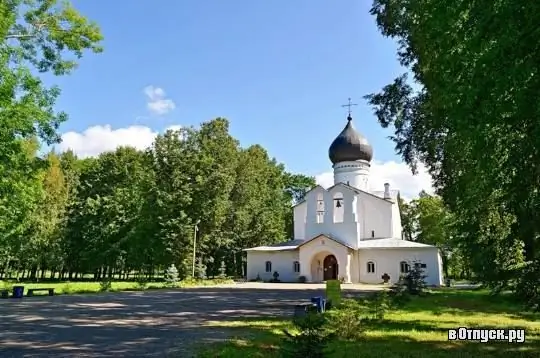
Description of the attraction
The Cathedral of the Sovereign Mother of God is located in the southeastern part of the Gdov Kremlin. Once it had a different name - the Cathedral in the name of Dmitry Thessaloniki, which was located in the central part of the Kremlin. In addition to the Church of Dmitry, the Gdovsk Fortress housed: the Church of the Assumption, as well as the church-bell tower, which were blown up by fascist troops in 1944. The LOIA archive contains material that allows you to trace the history of the development of the Church of the Sovereign Mother of God. Around 1906, the church was measured in detail by P. P. Pokryshkin, whose research, as well as part of the measurements, were published.
Around 1540, a stone Dmitrievskaya church was built in the Gdov fortress. In 1561, bells were cast for the bell tower of the Dmitrievsky Cathedral. According to the graphic records that have come down to our time, one can clearly trace the history of the construction of the Dmitrievsky Cathedral. According to the images of the drawings, until 1781, the church side-chapel was located at the southern wall. The plan of the church from 1854 shows the image of the south side-chapel, and also marks the location for several new side-chapels, which significantly enlarged the cathedral to the west.
The Cathedral of the Sovereign Mother of God, built on the foundations of the former Dmitrievsky Church, is a one-domed temple, standing on four pillars, slightly rounded at the bottom; the same pillars support a six-window drum equipped with a dome. On the west side of the temple, there are choirs equipped with corner chambers supported by vaults. There is a low bench in the church altar, which rests closely on the pilasters. The upper part of the building has two-stage bearing arches, and the drum has small slit-like windows.
The decorative design of the facade of the Church of the Sovereign Mother of God is made using flat blades equipped with two- and three-blade arches. To the architectural structure of the upper parts of the church, voices are used, which greatly facilitate the overall appearance of the structure, and also improve the acoustic sound in the temple. The apse and the drum are decorated with arches and a belt of triple depressions.
The porch on the western side, which is arranged on round low pillars and is covered with a two-slope roof and a box-shaped vault, roller divots located on the central apse, fronted sandriks located above the window openings of the drum - this is what became characteristic features of Pskov churches of the 15-16th centuries.
The temple has a belfry, as well as two side-chapels, one of which is consecrated in the name of St. Dmitry of Thessalon, and the second - in the name of the Martyr Benjamin.
Initially, the Cathedral of the Sovereign Mother of God had two thrones, the main of which was in the name of St. Dmitry, and the other in the name of the Savior Not Made by Hands. During 1854 the temple was rebuilt due to the construction of the chapel consecrated in the name of St. Mitrofan of Voronezh. The external appearance of the cathedral changed quite a lot, because a little later an extension was erected, in which they were installed: on the left - the chapel of Mitrofan, and on the right - the chapel of the Savior. The restructuring process took place according to the plan of the famous architect Morgan. The church became more elongated and began to accommodate about a thousand people. The main dome also remained under the old temple, and the second dome is located in the central part. Temple altars had semicircular apses. From the inside, the cathedral was subdivided into two equal components: warm side-altars and an ancient cold cathedral. With the help of an arch, side altars were connected, which led directly to the cathedral.
The main church iconostasis was carved. The consecration of the antimis was carried out in 1846 by Bishop Nathanael. At the altar there was an old icon named after the Sign of the Mother of God. The attractions of the cathedral include three bells with inscriptions. Among the icons of the church in the annals are the icons of the Forerunner, dating back to 1838, the icon of the Holy Trinity, located in the chapel of the Savior, the icon of Dmitry the Myrrh-streaming, as well as the image of Nicholas the Wonderworker. After the cathedral was destroyed by German fascists in 1944, it was restored in 1991 and consecrated in 1994.






